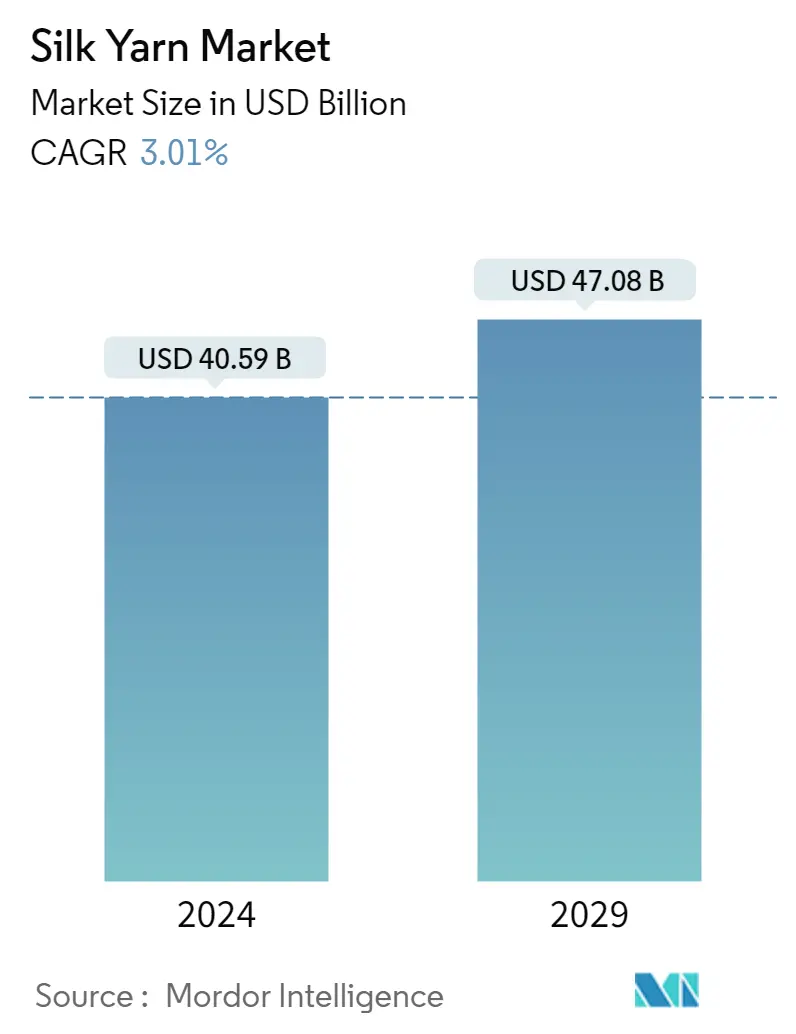Market Size of Silk Yarn Industry

| Study Period | 2019 - 2029 |
| Base Year For Estimation | 2023 |
| Forecast Data Period | 2024 - 2029 |
| Market Size (2024) | USD 40.59 Billion |
| Market Size (2029) | USD 47.08 Billion |
| CAGR (2024 - 2029) | 3.01 % |
Major Players*Disclaimer: Major Players sorted in no particular order |
Silk Yarn Market Analysis
The Silk Yarn Market size is estimated at USD 40.59 billion in 2024, and is expected to reach USD 47.08 billion by 2029, growing at a CAGR of 3.01% during the forecast period (2024-2029).
- The industrialization of the silk industry coupled with various government schemes will boost the production of raw silk in the Asia-pacific region which in turn increase the production of silk yarn making the region to be the largest market during the forecast period.
- Caribbean countries such as Cuba and African Countries including Kenya are making an effort to boost their silk yarn production.The Government of Rwanda as well as has begun investing in the development of silk value chains, with the rising demand from Asia, the production of high-quality silk products offers strong export opportunities. To tap into growing global markets, Rwanda's National Agricultural Export Development Board (NAEB) has also partnered with HEWorks, a Korean silk manufacturer.
- The sector is a major provider to foreign exchange reserves in nations such as India which is why the government supports with various initiatives to boost the industry. In India, sericulture operations are distributed throughout 52,360 villages. The country uses raw materials to manufacture silk garments, made-ups, textiles, yarns, carpets, shawls, scarves, pillow coverings, and accessories.
- Countries such as India, China, the United States of America, Italy, France, Switzerland, Japan, Vietnam, the United Arab Emirates, the United Kingdom, Germany, and Korea are some of the major consumers of silk and silk products. The industrialization of the silk industry coupled with various government schemes will boost the production of raw silk in the Asia-pacific region which in turn increases the production of silk yarn, making the region to be the largest market during the forecast period.
Silk Yarn Industry Segmentation
Silk yarn is widely used in the textile industry to produce clothing such as socks, neckties, and dresses. They are also used in manufacturing home decor fabrics such as flowering curtains, comforters, and so on. The Global Silk Yarn Market is Segmented by Geography (United States, China, India, Thailand, Germany, Italy, United Kingdom, Brazil, and Tunisia). The Market includes Production Analysis (Volume), Consumption Analysis (Value and Volume), Export Analysis (Value and Volume), Import Analysis (Value and Volume), and Price Trend Analysis. The report offers market estimation and forecast in value (USD thousand) and volume(metric ton).
| Geography (Production Analysis, Consumption Analysis by Value & Volume, Import Analysis by Value & Volume, Export Analysis by Value & Volume and Price Trend Analysis) | |
| United States | |
| China | |
| India | |
| Thailand | |
| Germany | |
| Italy | |
| United Kingdom | |
| Brazil | |
| Tunisia |
Silk Yarn Market Size Summary
The silk yarn market is poised for significant growth over the forecast period, driven by industrialization and supportive government initiatives, particularly in the Asia-Pacific region. This region is expected to dominate the market due to increased production of raw silk, which in turn boosts silk yarn production. Countries like India and China are major players, with India implementing schemes like Silk Samagra to enhance domestic silk quality and productivity. The market is also witnessing efforts from countries such as Rwanda, Cuba, and Kenya to develop their silk yarn production capabilities, tapping into the rising global demand for high-quality silk products. The collaboration between Rwanda's National Agricultural Export Development Board and Korean silk manufacturer HEWorks exemplifies the strategic partnerships being formed to leverage export opportunities.
In Europe, Italy is emerging as a significant producer of silk yarn, with companies like ONGETTA SRL leading the way in organic silk production. The decrease in Chinese silk yarn exports is providing Italian producers with greater access to global markets, as the price of Chinese silk continues to rise. Despite Italy's growing presence, China's dominance in silk production remains unchallenged, with the country being the largest producer and exporter worldwide. Uzbekistan is also a key player, working to enhance its silk industry through initiatives like "UZBEKIPAKSANOAT." The global silk yarn market is characterized by these dynamic developments, with various countries striving to strengthen their positions through innovation, collaboration, and strategic government support.
Silk Yarn Market Size - Table of Contents
-
1. MARKET DYNAMICS
-
1.1 Market Overview
-
1.2 Market Drivers
-
1.3 Market Restraints
-
1.4 Value Chain Analysis
-
-
2. MARKET SEGMENTATION
-
2.1 Geography (Production Analysis, Consumption Analysis by Value & Volume, Import Analysis by Value & Volume, Export Analysis by Value & Volume and Price Trend Analysis)
-
2.1.1 United States
-
2.1.2 China
-
2.1.3 India
-
2.1.4 Thailand
-
2.1.5 Germany
-
2.1.6 Italy
-
2.1.7 United Kingdom
-
2.1.8 Brazil
-
2.1.9 Tunisia
-
-
Silk Yarn Market Size FAQs
How big is the Silk Yarn Market?
The Silk Yarn Market size is expected to reach USD 40.59 billion in 2024 and grow at a CAGR of 3.01% to reach USD 47.08 billion by 2029.
What is the current Silk Yarn Market size?
In 2024, the Silk Yarn Market size is expected to reach USD 40.59 billion.

